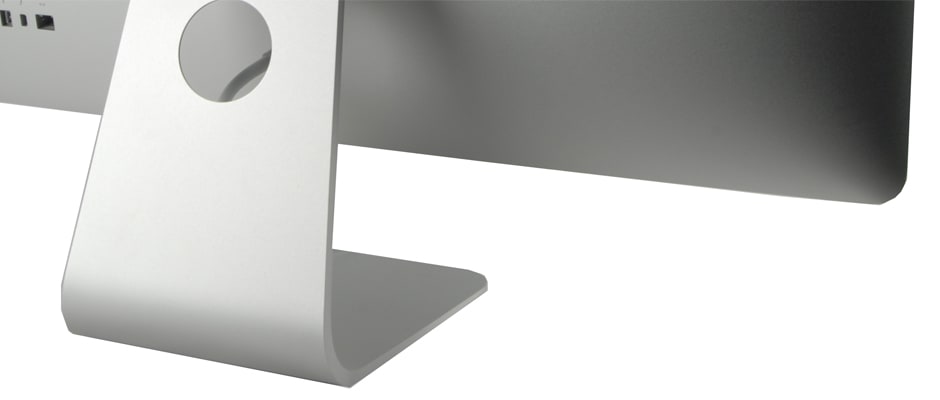Pros
Cons
Introduction
Overall Design
{{section_header}}{{section.name}}{{/section_header}}
A study in stark contrasts, the Thunderbolt Display is by no means a colorful monitor. It has a wide black screen that blends seamlessly into the bezel, whereas the stand and back of the display are a smooth, brushed aluminum. The ports are small and out of the way, leaving only the display and monitor to take the spotlight, with nary a hard corner in sight. All in all, the Thunderbolt Display looks sleek, smooth, and stylish.
Front
{{section_header}}{{section.name}}{{/section_header}}
As you can see from the photo, the powered off display makes for an imposingly dark finish. The bezel is almost invisible, and blends seamlessly into the 27-inch display while the monitor is powered off. Only the small, subtle Apple logo reminds us what we're looking at.
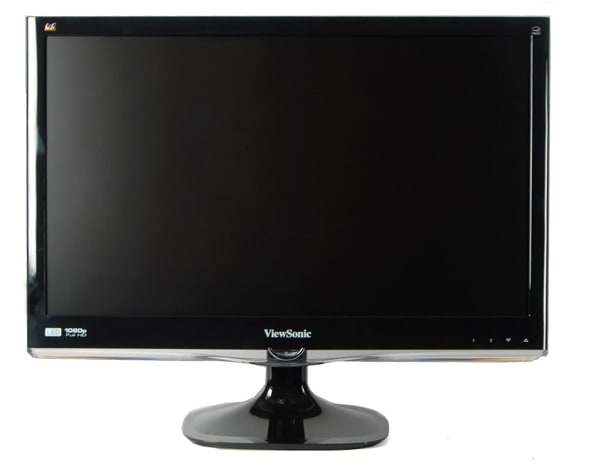
Back
{{section_header}}{{section.name}}{{/section_header}}
The back and stand are both made of the same brushed, smooth aluminum. In contrast with the front, the back of the display features a bold black imprint of the Apple logo.

Side
{{section_header}}{{section.name}}{{/section_header}}
As with most widescreen LED displays, the Thunderbolt's profile is quite thin.
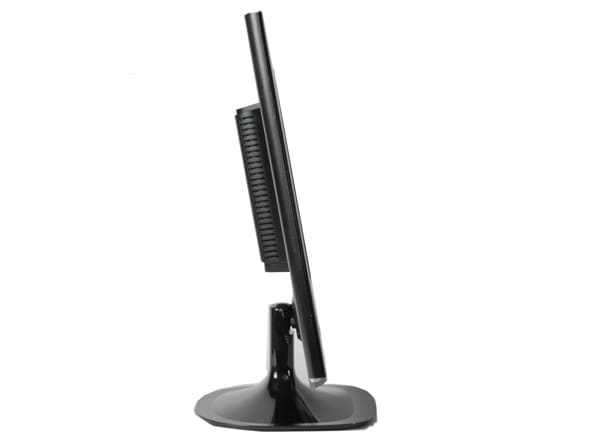
Stand
{{section_header}}{{section.name}}{{/section_header}}
The stand is a simple, curved platform that balances the display nicely.

In the Box
{{section_header}}{{section.name}}{{/section_header}}
The Apple Thunderbolt Display comes with its power cable, permanently attached MagSafe and Thunderbolt connectors, the manual, and warranty information.
Contrast
{{section_header}}{{section.name}}{{/section_header}}
As you can see from the comparison chart below, 850:1 is a great maximum contrast ratio where monitors are concerned, and as far as we know is about as good as it gets (or needs to be). The Thunderbolt had some of the deepest blacks we've seen on a monitor so far, and managed to avoid being blindingly bright while still maintaining a good contrast ratio. More on how we test contrast.

Uniformity
Color Temperature
{{section_header}}{{section.name}}{{/section_header}}
Our testing revealed a very consistent and accurate degree of color temperature across the entire spectrum, with very little degree of error and no perceptible error to the human eye. More on how we test color temperature.

Color Curves
{{section_header}}{{section.name}}{{/section_header}}
The Thunderbolt display tested gradual, smoothly sloped curves, with red and blue taking just slightly too long to peak--hence their mild undersaturation, which is more apparent below in the color gamut chart. Greens and whites will be just about perfect, however. For most users, the Thunderbolt Display's color accuracy will prove more than satisfactory. More on how we test color curves.
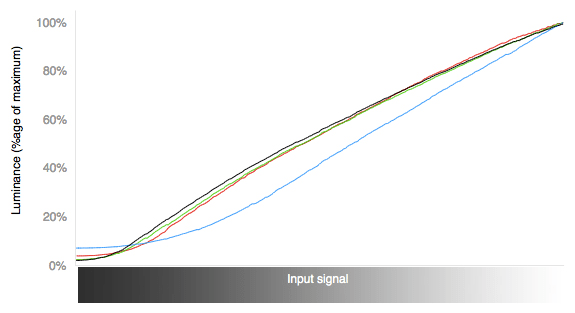
Color Gamut
{{section_header}}{{section.name}}{{/section_header}}
The Apple Thunderbolt display matched the sRGB color gamut not without some degree of accuracy, but it was unfortunately a bit undersaturated on the red and blue sides of the spectrum. This isn't the kind of thing that would be a big deal for everyday monitor use, but it might be a problem for any profession that requires very accurate color reproduction. More on how we test color gamut.
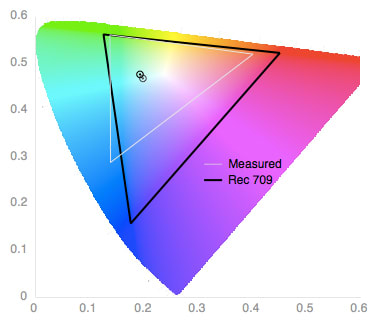
Viewing Angle
{{section_header}}{{section.name}}{{/section_header}}
We found that at 45 degrees, the contrast ratio for the Apple Thunderbolt display fell noticeably, from a contrast ratio of 850:1 to a contrast ratio of 18:1. While this is surprisingly low, it may not prove to be much of a problem unless you are attempting to view the Thunderbolt display with a group, and its 27-inch screen is wide enough for at least three people to watch at a head-on angle.

Calibration
{{section_header}}{{section.name}}{{/section_header}}
To test a monitor's full potential, we use two different calibrated luminosities. The first calibration involves optimizing the monitor to its own native luminosity, which is usually fairly high. This calibration is used for our contrast and viewing angle related analyses, and is meant to showcase how the monitor does for more general use, say in an office or living room, somewhere with more and/or brighter lighting. The second calibration involves optimizing the monitor to a luminosity of 160 cd/m2, quite dark without being overly dark. This calibration is used for our color temperature and color curves testing, and is meant to showcase how accurately the monitor renders colors on the sRGB or Adobe RGB spectrum. All of our calibration is done using the X-Rite iDisplay sensor.
Connectivity
{{section_header}}{{section.name}}{{/section_header}}
Before getting into the connection options available to the Apple Thunderbolt display, we feel it's important to point out, regardless of how obvious it is, that this monitor can only be used with Mac computers. This places very clear limitations on the Thunderbolt Display, but only within the realm of less specialized monitors. Within the world of Mac, however, the Thunderbolt Display is fairly versatile. It has 3 USB 2.0 ports, a second Thunderbolt input (making it easy to, for example, connect a second Thunderbolt display to the first), a FireWire input, and an ethernet port.
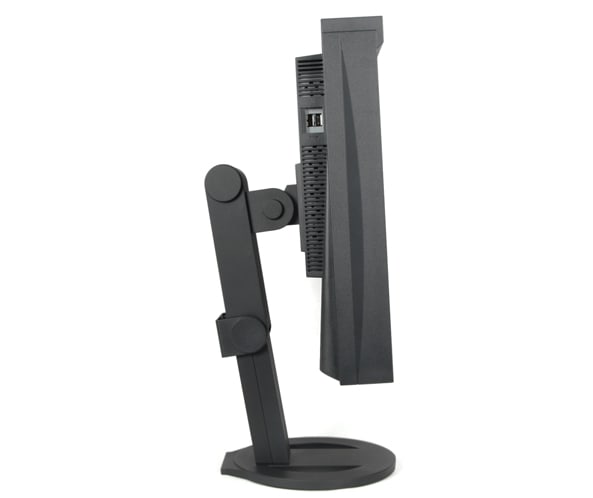

Controls & Menus
{{section_header}}{{section.name}}{{/section_header}}
The Thunderbolt Display features no on-site controls of any kind, and thus does not have a built-in menu. It can be adjusted and calibrated from the computer that it is running off of, be it a Mac mini, a MacBook pro, etc. In this sense, it is less like a traditional monitor and more like a display enhancement of sorts. Apple is sticking to their tradition of product inclusion and an almost forced sense of minimalism. This is the kind of thing that some people love, and some people hate.

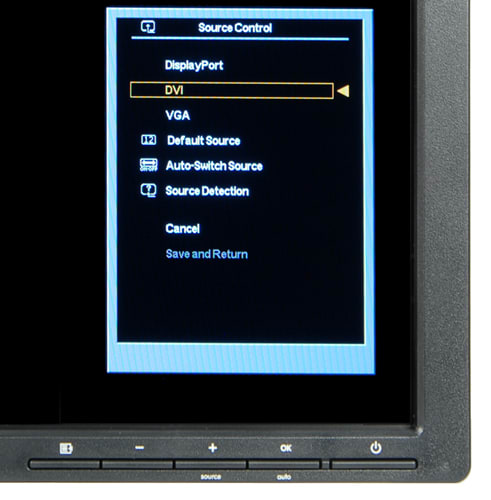
Other Features
Comparison Overview
{{section_header}}{{section.name}}{{/section_header}}
The Apple Thunderbolt Display (MSRP $999) is quite a bit more expensive than the HP ZR24w (MSRP $349), and also has the limitation of being Mac only. They performed similarly in contrast and color, with the HP performing a little bit better at maximum contrast ratio because of its extremely high peak white, and the Apple performing slightly better on our color temperature test. The HP offers more connectivity options, but the Apple has pretty nice built-in speakers and an HD camera. The choice between these two is really down to the user and their budget--you get a 27-inch widescreen display with one of the highest resolutions on the market with the Thunderbolt Display, but you're going to pay for it, too.
Comparison Overview
{{section_header}}{{section.name}}{{/section_header}}
The Thunderbolt Display is about a third the price of the Eizo CG245W, and they are very different monitors. For $999, you get a Mac-niche display with a big, gorgeous screen and very simple set-up and connectivity. The Thunderbolt is not marketed for use in a profession requiring perfect color accuracy, whereas the Eizo--for about $3000--is one of the best artist's monitors we've reviewed, offering built-in calibration, a screen hood, and a more involved set-up process. The only thing to learn from comparing these two monitors is what their price tags teach us: they are both, in a way, specialized to a purpose, and sit on either end of a spectrum describing the difference between high-end resolution for general use and high-end color accuracy for professional use.
Comparison Overview
{{section_header}}{{section.name}}{{/section_header}}
The Acer S231HL has a $150 MSRP, and performs to that standard. It has decent color accuracy for general use, but overall is not very flexible in its connectivity, nor is it aesthetically attractive. It has bare bones features, and is a cheap monitor best used as a backup in an office or multi-display kind of setting. For $999, the Thunderbolt offers a similar idea for Mac users, except that it offers all the clean stylishness we've come to expect from Apple, as well as one of the highest resolution displays we've yet seen. The difference is clear, and we hope to have clarified the rationale behind the Apple's price tag.
Conclusion
{{product.vanity}}
The Thunderbolt Display is very attractive, and has the performance parameters and flexible features to back up its $999 MSRP. Mac users with the budget to invest in this display will not be disappointed; if you've found you need some extra real estate for your Mac workstation, or perhaps feel that you'd enjoy your MacBook a little more if you could render it upon a 27-inch widescreen display, the Apple Thunderbolt Display will likely be on top of your wishlist.
Its only drawback within the world of monitors as a whole is that it is only usefully available to Mac users, and without a Mac powering it, is little more than an elegant paperweight. It serves no value unless it is paired with a Mac computer (which, in turn, must be Thunderbolt-input equipped, so anything before 2011 is out). Hence, the exact value boils down to the user and what they have at their disposal.
Mac necessities aside, the Apple Thunderbolt display is gorgeous and, for what it brings to the table, comparably affordable. While businesses and studios could score stylishness points just for having one (or more) set up on location, the bottom line is that on top of being such an attractive and impressive monitor in appearance, it is also an attractive and impressive monitor in performance, and has the design sensibility and built-in features to prove useful for both recreational and business use.
Photo Gallery
{{photo_gallery "Front Image", "Back Image", "Side Image", "Stand Photo", "Stand A", "Stand B", "Stand C", "Controls Photo", "Connectivity Photo 1", "Connectivity Photo 2", "Menu Photo", "Controls Photo"}}
Meet the tester
Lee was Reviewed's point person for most television and home theater products from 2012 until early 2022. Lee received Level II certification in TV calibration from the Imaging Science Foundation in 2013. As Editor of the Home Theater vertical, Lee oversaw reviews of TVs, monitors, soundbars, and Bluetooth speakers. He also reviewed headphones, and has a background in music performance.
Checking our work.
Our team is here to help you buy the best stuff and love what you own. Our writers, editors, and experts obsess over the products we cover to make sure you're confident and satisfied. Have a different opinion about something we recommend? Email us and we'll compare notes.
Shoot us an email